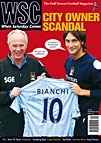 Do you have an idea how many key passes Darren Fletcher has had in the Champions League? Would you remember enough about Frank Lampard’s various performances against Barcelona to be able to take a guess at his total yardage? Good luck to you if you do, because we haven’t got a clue. And neither would anyone else 15 years ago. In the century of football that occurred in the pre-Sky age, supporters somehow managed to cope without knowing how much ground a certain player covered or whether he was statistically his team’s fifth-best decision-maker in the final third.
Do you have an idea how many key passes Darren Fletcher has had in the Champions League? Would you remember enough about Frank Lampard’s various performances against Barcelona to be able to take a guess at his total yardage? Good luck to you if you do, because we haven’t got a clue. And neither would anyone else 15 years ago. In the century of football that occurred in the pre-Sky age, supporters somehow managed to cope without knowing how much ground a certain player covered or whether he was statistically his team’s fifth-best decision-maker in the final third.
It’s likely that you’ll be hearing more and more conversations about this kind of statistic as a droning background in the coming season, at work, on public transport, perhaps even at another league match – and you can be certain that they’ll be filling up vast amounts of airtime given over to that increasing blight of the modern age, the phone-in. And the bigger the club, the more and louder the conversation. Though diligent data entry goes on for every top-flight game, it is something of a rarity to see this kind of analysis applied outside the top four in the league.
Part of this is driven by gambling. Once you have these statistics and these rivalries it’s possible to bet on outcomes that used not to exist. Although in some cases you might just as well gamble on the number of noughts in a pair of randomly selected telephone numbers. There is a degree to which this is the Americanisation on the game, too. It is possible to reduce baseball and gridiron, especially, to a series of statistics, because all the action consists of short set plays. Basketball also, even if the passages of play are longer. Football, in which continuous play can last seconds or minutes and so much is subjective, is resistant to such number-crunching, but that won’t stop some from trying.
Danny Finlkelstein, the political consultant who did such a good job at bringing the SDP into government then helping the Tories win back power since 1997, is the “brains” behind another attempt to turn football into statistics, via his “Fink Tank” column in the Times. He produces such bewildering nonsense as the claim about Arsenal in February that there was “a 17 per cent chance they will finish second” in the Premiership (“and a one per cent chance they will be champions”). Or that Aleksandr Hleb was one of the ten most effective players in the top flight last season.
There are other strange debates being generated, some a side-effect of the emergence of the new international football fan. The new international fan is just as animated – and just as irritating – discussing the form of Barça, Juve or Real (we’re all on short-name terms these days) as any of their England-based Champions League buddies. New, albeit largely televisual, club rivalries are threatening to emerge among the game’s chattering classes: midweek inter-league “derbies” such as Liverpool v AC Milan, Chelsea v Barcelona, even Manchester United v Lille.
So far it hasn’t seemed to matter particularly that, for all but the travelling hardcore (approximately 0.3 per cent of the total TV audience on any given night), these rivalries exist only on a television screen and in their newspaper. In fact, over the next ten months this will only add to the ever-expanding multi-media coverage of the smallest statistical minutiae of the Big Four’s progress in their various mini-leagues.
As ever, this intimate cut and thrust among the elite clubs will continue to hover suspended like a cloud city above the reality of most football supporters’ experience of their club and the game; a version of football that exists only once it has been edited into a choppy musical montage with Andy Gray shouting “unbelievable!” over the top and then painstakingly dissected, not just over six pages of your broadsheet sports supplement, but by the bloke in the pub in the Barcelona shirt who keeps calling Ronaldinho “Ronnie”.
Football’s phenomenal success is in large part down to its simplicity – like athletics, the only other truly global sport (if you exclude fighting). In track and field the only numbers that matter are time, height and distance; in football it’s goals and points. Much more than that is worse than unnecessary, actually detracting from the game’s appeal. Rather than finding yet another way of comparing the Big Four, why not, you know, look at some of other 16 top-flight teams? Or the 72 beneath that? The blizzard of information now available isn’t really adding to the sum total of knowledge – it’s just creating more noise. Get set to hum loudly for the next ten months.
From WSC 247 September 2007